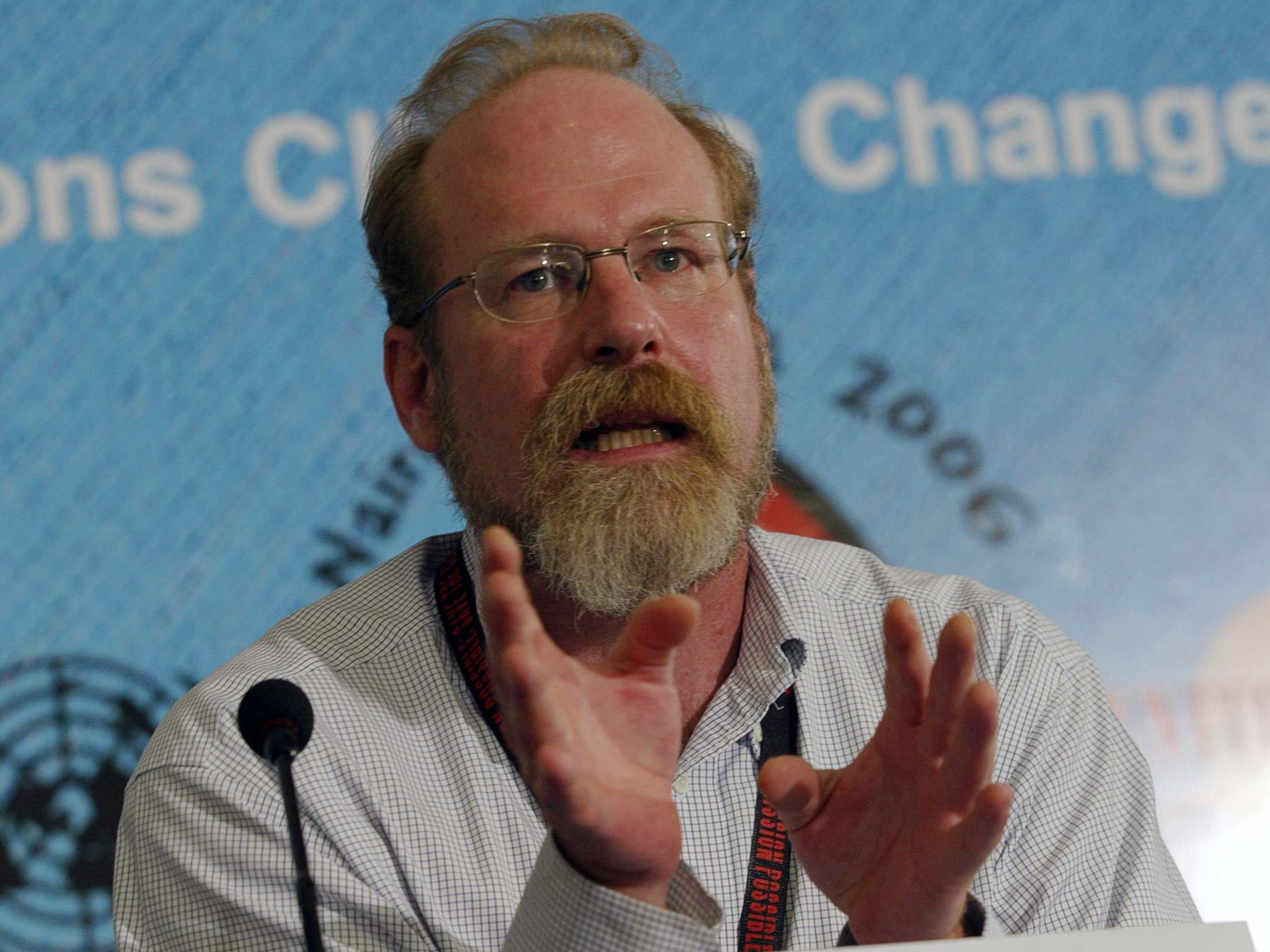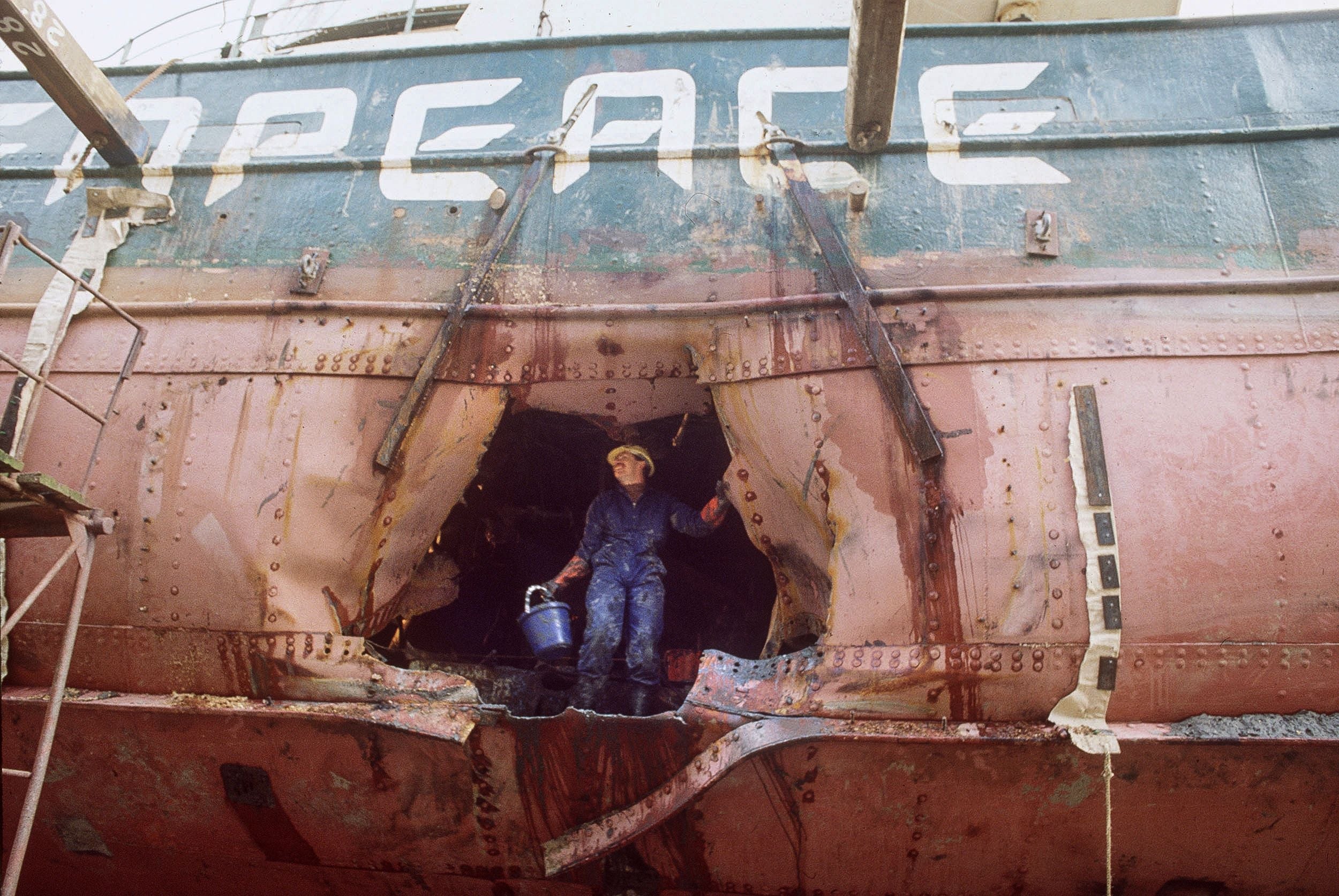Steve Sawyer: Greenpeace leader who escaped the bombing of the Rainbow Warrior
An activist associated with some of the environmental group’s most confrontational missions, Sawyer soon became its executive director

As a young Greenpeace activist, Steve Sawyer narrowly avoided injury in 1985 when the environmental group’s ship Rainbow Warrior was sunk by sabotage in New Zealand. Sawyer, who has died of lung cancer aged 63, later became executive director of Greenpeace International and redirected its focus towards the fight against climate change.
While growing up in New England, Sawyer became a skilled sailor. He used his expertise to help to refurbish an ageing British trawler for Greenpeace in the late 1970s and early 1980s. Rechristened the Rainbow Warrior, it became the flagship in Greenpeace’s efforts to prevent nuclear testing and to promote ecology.
Since the organisation’s founding in 1971, Greenpeace had cultivated a daring, anti-authoritarian and sometimes confrontational approach to environmental protection. Its members were sometimes called eco-warriors, even though nonviolence was one of the guiding principles of Greenpeace.
“For us, it wasn’t blind idealism,” Sawyer said in 2005. “It’s hard to tell people who weren’t around then about living in daily fear of crazy old men in Moscow and Washington who had their fingers on the nuclear buttons, and might at any time cause the Big Bang.”
At different times, Greenpeace activists darted through dangerous waters in small boats to prevent Japanese and Russian whalers from discharging their harpoons. They landed on the coast of Siberia to protest against Soviet whaling practices. They handcuffed themselves to drums filled with toxic waste to keep them from being dumped into the ocean. They protected baby seals about to be killed in Canada, sometimes spraying them with green dye to make their white fur worthless to hunters.
Many of these guerrilla-like episodes were caught on film, adding to Greenpeace’s reputation as the renegade pirate outfit of the environmental movement.
In 1985, Sawyer was one of around a dozen Greenpeace crew members aboard the Rainbow Warrior when it embarked on a dual mission in the Pacific. The first was to remove inhabitants from the atoll of Rongelap in the Marshall Islands, which had been the site of US nuclear tests in the 1950s.
Residents had unusually high rates of cancer and birth defects, but US officials ignored their requests to move off the nuclear-contaminated atoll. Over a 10-day period, Sawyer and the Rainbow Warrior crew evacuated about 300 residents, their livestock and possessions to another atoll around 100 miles away.
The second mission of the Greenpeace crew aboard the Rainbow Warrior was to lead a flotilla to an atoll in French Polynesia, in an effort to block underground nuclear tests by the French. The Rainbow Warrior was docked in Auckland, New Zealand, when two bombs exploded below the ship’s waterline just before midnight on 10 July 1985.

The Rainbow Warrior was damaged beyond repair and listed to one side, half-submerged in the harbour. After the first explosion, Greenpeace photographer Fernando Pereira sought to retrieve his camera equipment. He was killed in the second blast. There may have been greater loss of life if most of the crew members hadn’t been ashore, celebrating Sawyer’s 29th birthday.
New Zealand police quickly arrested a man and a woman who claimed to be Swiss citizens on vacation. Further detective work revealed that they were French undercover agents who had planted the bombs on the side of the ship, then fled the scene with the help of accomplices.
After an international outcry, the two intelligence agents who planted the bombs were sentenced to prison, and a cover-up scandal tainted the French government. With the legal help of one-time White House counsel Lloyd Cutler, Greenpeace sued the French government and ultimately received a settlement of around $8m.
In 1986, Sawyer became Greenpeace’s US director, overseeing a rapid surge in membership, donations and global recognition. Two years later, he became the executive director of Greenpeace International, moving to London and later to Amsterdam, where the group maintains its global headquarters.
Over time Sawyer shifted Greenpeace’s focus towards efforts to tackle climate change and develop sources of renewable energy. “The environment has to rise to the number one issue on the world agenda,” he said in 1989. “The dramatic actions we were once known for aren’t always necessary these days to bring things to people’s attention. Sometimes we can just point a finger and it’s enough.”
Yet, in many ways, he and his organisation were defined by the bombing of the Rainbow Warrior and their defiance in the face of what they called state-sponsored terrorism. “It was my 29th birthday,” Sawyer said in 2005. “That’s something I can never forget. Every year I’m forced to remember it.”
Stephen Gregory Sawyer was born in 1956 in Boston and grew up in Antrim, New Hampshire. His father was an engineer, his mother a piano teacher. He graduated in 1978 from Haverford College in Pennsylvania with a bachelor’s degree in philosophy. While contemplating his career options, he met a door-to-door canvasser for Greenpeace and soon joined the group. He raised money and did other jobs for Greenpeace, including leading the refitting of the Rainbow Warrior, which was converted to a sailing vessel.
He stepped down from day-to-day leadership of Greenpeace in 1993 but remained closely allied with the organisation, participating in reunions of the Rainbow Warrior crew. He later helped to found the Global Wind Energy Council, which he led from 2007 to 2017.
He is survived by his wife Kelly Rigg and two children.
Steve Sawyer, environmental activist, born 10 July 1956, died 31 July 2019
© Washington Post
Join our commenting forum
Join thought-provoking conversations, follow other Independent readers and see their replies
Comments